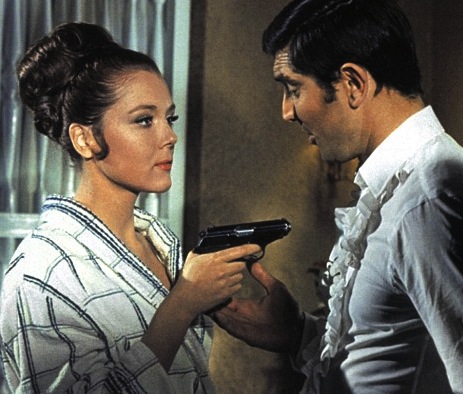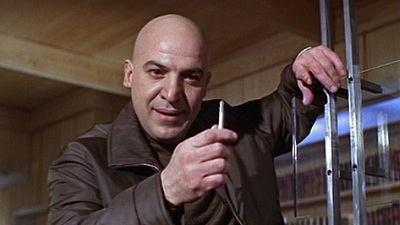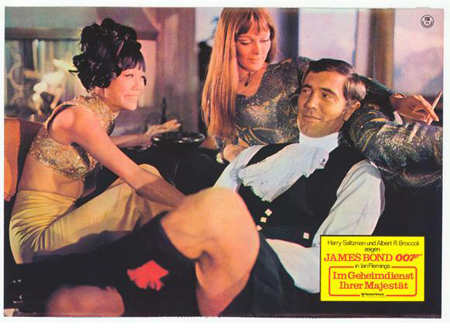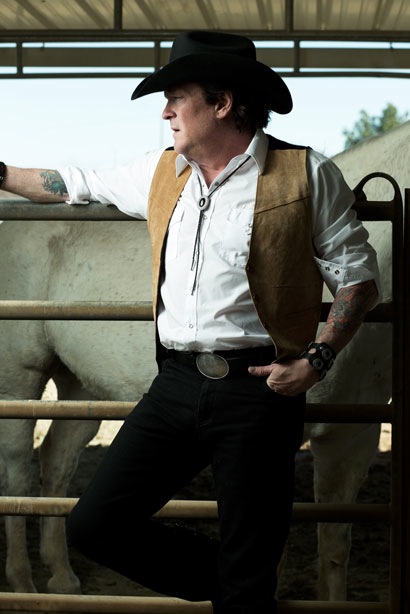
Michael Madsen. Photo credit: Isaac Alvarez. Weinstein Co. Used with permission.
By Gregory Nicoll
Contributing Writer
“I don’t always play bad guys,” observes Michael Madsen, his voice as raspy and powerful as a Harley-Davidson’s exhaust pipe, “but for some reason when I do, it gets more attention than when I play somebody who doesn’t have a gun.”
Even without a firearm in his hand, the burly 6’ 2” actor radiates an onscreen menace so palpable it inspires nightmares. His breakthrough role was playing Mister Blonde in Quentin Tarantino’s RESERVOIR DOGS (1992), for which he tortured a policeman with a razor and gasoline in one of the most disturbing sequences of ’90s cinema. But despite equally convincing performances in high-profile good-guy parts – such as the loving dad in FREE WILLY (1993), the action hero in SPECIES (1995), and a stoic lawman in WYATT EARP (1994) – Madsen still finds himself cast more often on the dark side, with unforgettable bad-guy turns in KILL BILL (2003/2004), HELL RIDE (2008), DONNIE BRASCO (1997) and THE GETAWAY (1994) His latest movie is Tarantino’s much-anticipated new western, THE HATEFUL EIGHT, which opens on Christmas day in an extended limited-release 70mm Ultra-Panavision “Roadshow” presentation with a overture and an intermission (Regal Atlantic Station 18), with a wide release starting Dec. 30 (Landmark Midtown Art Cinema, etc.).
We spoke with Michael Madsen by phone from his seaside California home.
ATLRetro: Let’s hear about THE HATEFUL EIGHT. Sure hope you’re not weary of talking about it.
Michael Madsen: Not really! It’s hard to get weary of Tarantino, who’s such a force to be reckoned with. This is the third time he’s reached out to me with, “Let’s get on the bus.” Only in this case it’s, “Let’s get on the horses!”
So, this is a western about characters who all get stranded together after their stagecoach is re-routed?
It’s pretty hard to put a lid on what it is, but it’s about a bunch of eight people who’ve got an agenda, an agenda that’s pretty complicated. The script was one of the most fascinating things I’ve ever read. I guess it’s somewhere between THE MAGNIFICENT SEVEN (1960) and THE DIRTY DOZEN (1967).
 Is there any previous classic western movie to which it could easily be compared?
Is there any previous classic western movie to which it could easily be compared?
Well, maybe ONE-EYED JACKS (1967), which is probably the greatest western I’ve ever seen. It’s the only picture Marlon Brando ever directed, taking over from Stanley Kubrick. I just love it. ONE-EYED JACKS is about everything. There’s nothing that it isn’t about. There are so many themes in there, it’s mind-boggling. It’s one of Marlon’s finest. Him and Karl Malden are so wonderful together, it’s just unbelievable.
Karl Malden was fabulous in just about everything, from A STREETCAR NAMED DESIRE (1951) to NEVADA SMITH (1966).
That was with Steve McQueen. What a power he was on the screen! [Quoting NEVADA SMITH] “You haven’t got the guts!” Yeah, he’s shot in the kneecaps and it’s pretty horrendous, but, wow…
When I first moved to Malibu, I lived right next door to Steve McQueen. Steve was one of those guys who came along at time when the movie industry – when Sam Peckinpah and John Sturges and Norman Jewison were making films. Those kind of directors, they don’t really exist anymore. They were as much responsible for Steve’s success as he was himself, the combination of him, a personality like that, put together with those kinda directors. Steve was one of a kind and he made some – well, I like THE GETAWAY (1972). To me, that’s the quintessential Steve McQueen movie. I got to be in the remake of it, which was great, but I would have preferred to play Doc McCoy [McQueen’s role]. Alec [Baldwin] did a good job, but I think I coulda pulled that off.
The character of Doc in the original Jim Thompson novel THE GETAWAY has much more of an edge to him than in the films.
Well, I teased Alec constantly during the making of that thing. Every single time we were on the set and he was doing something, I’d go, “You remember the way Steve was standing?” or, “You remember the way Steve was holding the gun?” or “When you look around the corner, you remember how Steve did it?” and he’d go [imitating Baldwin’s voice], “Madsen! Shut up, Madsen! You’re driving me crazy.” It was really funny. I teased him quite a bit, but he had a good sense of humor about it. At the end of the film he actually bought and gave me the Smith & Wesson handgun that I used in the movie.
Speaking of firearms, will we be seeing much of the trademark Tarantino gunplay violence in HATEFUL EIGHT?
Oh, sure. Of course. Wouldn’t be the same without it.
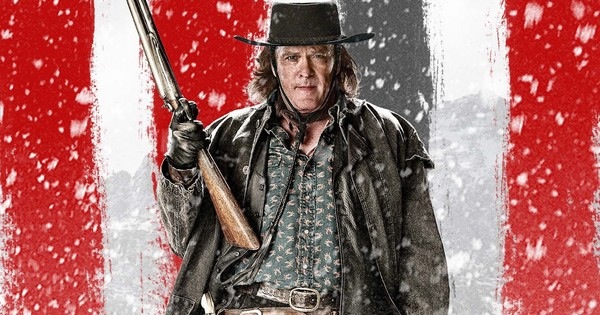
Michael Madsen in HATEFUL EIGHT. Weinstein Co. Used with permission.
Last year Tarantino was furious when his HATEFUL EIGHT script got leaked online, and you were one of the few insiders who’d been given a copy.
People actually thought it was me! I was in Italy at the time. My buddy and I were on an elevator, this was about 2 :00 in the morning and we’d just got back to the hotel, and he was looking at his phone, and all of sudden he goes, “Oh my god!” And I go, “What is it?” And he goes, “Oh, Michael, oh my god, somebody leaked out Quentin’s script and he’s all pissed off, and he says he only gave it to three people, and it wasn’t Tim [Roth].” And I was, like, “Holy shit, man, it sounds like I’m a suspect!” So I called him the next day and I said, “Quentin, man, say something to somebody, because obviously it wasn’t me.” And he started laughing actually. He thought it was funny that this had so quickly been heard about as far away as Italy, that the very next day it was worldwide news.
Not much later you participated in a staged public reading of the HATEFUL EIGHT script. Was Tarantino directing you live on stage?
Oh, he sure was, he had on a black cowboy hat and was coming over to the actors and giving them direction, right in front of everybody. Quentin read all the stage directions aloud. He had a coffee pot for a prop, and I had a bandana for my prop. It was a fascinating night. I’ve never done anything like that.
Did you rehearse for this?
Yeah, we rehearsed for three days before the show, and once in the afternoon right before the show. It was a lot of hustling around to get everybody together, but to have the whole cast together in one room and start reading through this thing, and putting it up on its feet, and to know now that we’re actually gonna go and film it later, it was a great, great, great kind of boost for me.
How did it feel to have that immediate feedback from the audience? People must have been laughing, reacting in various ways…
Well, everybody was very, very respectful. That’s what I remember. I’d seen everybody coming in, because I was in the back as the theater started to fill up, and I’d been looking out the windows in the front of the building, and everybody was all dressed up! It was really kind of an evening with all the girls all dolled up and guys dressed up. Nobody was allowed to bring their phone inside or have any kind of recording devices.
I heard that you don’t carry a cell phone. Is that still true?
I don’t like them, put it that way. I didn’t even get an iPad till about six months ago. I just really didn’t get the point of it. I would see people on their phones in the car, on their phone constantly, and when I had one myself it seemed like I became so dependent on it. I started wondering why does everyone need it so badly when no-one ever had it before, and back then everyone got along fine. Was it really that important to talk to somebody if you can call ‘em an hour later? But I have five kids, and I gotta have a phone, but I frequently don’t charge it up and “accidentally” leave it somewhere, and I try really hard not to become obsessed with it. I heard that Christopher Walken doesn’t have a cell phone, and he’s my hero; and if he honestly doesn’t – or if he’s just saying that to sound cool – I don’t know, but I’m hoping he really doesn’t have one.
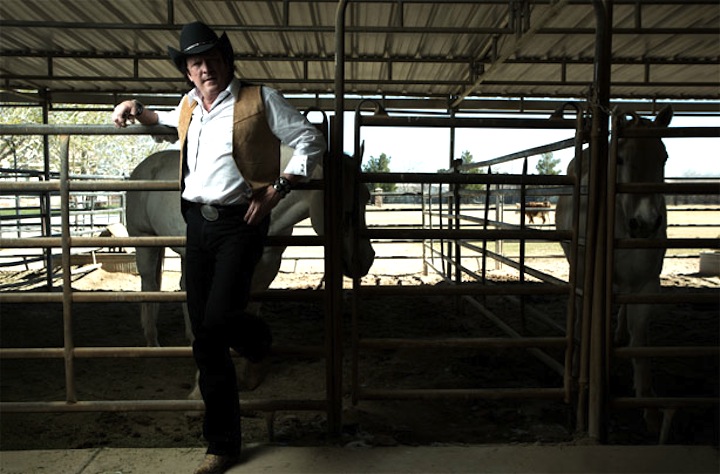
Michael Madsen. Photo credit: Isaac Alvarez. Weinstein Co. Used with permission.
Speaking of contemporary actors, you recently worked with Danny Trejo on a film called HOPE LOST. What was that like?
I’m not real fond of that title but, uh, it was shot in Rome and it’s basically about girls sold into the sex trade. The movie is a little rough, not for everyone. When you’re working on lower budget things, sometimes you have a bit more control over dialogue and scenes. In the original script I did some terrible things and got killed, but I didn’t end up doing that. My character lives, and I actually walk away from a bad situation at the end. Danny’s such a great actor and wonderful presence on screen. You walk the streets of Rome with Danny, and people come out of the restaurants shouting, “Machete! Machete!” Pretty funny. He’s Machete, no doubt about it. He’s got that mug!
I always wanted to see you cast as James Bond’s CIA counterpart, Felix Leiter, in the 007 series. That unfortunately didn’t happen, but you did get that nice supporting bit in DIE ANOTHER DAY (2002).
I loved working on that! Pierce Brosnan was a friend of mine and he lived right down the street from me, and that’s how that kinda happened. I went and I met [007 film producer] Barbara Broccoli, and they wanted to find a spot for me, and I did that one. I would have come back, I would have loved to. Judi Dench was such a great pleasure to work with. Having a Bond film as a credit is pretty cool. I’d like to do a few more.
You did an episode of HAWAII FIVE-O in 2014 which was notable because you were a bad guy who turned out to be a good guy.
What happened was, I’d heard there was some interest in having me on the show, and I was a huge, huge fan of the old show [the original HAWAII FIVE-O series which ran from 1968 to 1980]. That music, that opening title sequence is so bitchin’ and I remember watching that show most of my life, and just thought it was super cool. You can’t touch that thing. When they were interested in me, it was like a boyhood dream to be on HAWAII FIVE-O, but when they started calling me to do it, I said, “You know what, man, I’m not gonna come on the damn thing if you’re gonna kill me. There has to be something else. I’m gonna come in and get thrown down the steps by Scott Caan and then at the end get killed in a shoot-out. Please, please come up with something better for me.” And so, it really wasn’t until six months later after that conversation that they actually called me to do the show, and obviously when I read the script, the ending was the wonderful thing about it. You realize that this guy wasn’t such a bad person, and there’s this huge redemption, and that’s why I did it. I’ve never seen the episode; I was out of the country when it aired. I got a lot of compliments from my family about it.
 You were crammed into the tiny backseat of that Chevy Camaro for much of the time.
You were crammed into the tiny backseat of that Chevy Camaro for much of the time.
Being trapped in a car with Alex O’Loughlin and Scott Caan is an interesting experience. Both of those guys are good actors and I had fun with them, but if they’re not complaining about being stuck in Hawaii, all they do is talk about cigars all day.
They complain about being in Hawaii?
These two guys, you gotta understand, were in their fourth season, and after that many episodes I would imagine that sooner or later it might start to get to you. I saw Scotty in the parking lot in the early, early morning on my first day, and I said,”Hey man, where’s a good place to eat?” And he goes, “L.A.!” [laughs]
Hey, you know who directed that episode? Peter Weller, ROBOCOP (1987)! Peter’s a really intelligent guy, and I really enjoyed working with him. He really gave me a wide berth, let me come in and do my thing. He understands the actor’s dilemma, and he’s very, very methodical in his direction of exactly how he wants certain things. I was lucky to have him there because I wanted that thing to matter, I wanted that to be a good episode, I was thrilled to be on it, and to have him direct it made it just that much better.
I’m betting that you personally own some cars that are cooler than Danno’s Camaro.
Well, over the years I certainly have had some interesting vehicles. I entertained my boyhood fantasies after I started making some money as an actor. I got a ’57 Chevy small block and put dual quads on the damn thing. I had a Stingray with a big block four-speed. I went through a couple of Plymouth Roadrunners and even a Superbird. The thing is, you get these cars that you’ve always dreamed about having, and you end up with flat tires and dead batteries. You can’t really drive them that much, and you have to keep them somewhere, and it ends up being an expense that doesn’t make sense, especially if you have children. A lot of my toys are gone. I let most of them go. The last one I had was a ’67 GTO; that was really pretty cool. I bought it from the original owner. I got a couple motorcycles and I still have my Jaguar, but I’ve recently – funny you should say – I’ve recently started to get that feeling again. Wouldn’t be nice to have a nice 427 Chevelle downstairs? Nice fuckin’ four-speed convertible. I was even thinkin’ of getting something for my son, something we can build together.
Are you a liquor guy or a beer guy?
I’m not any one thing. I think drinking is one of those things that requires moderation. I like to have some wine with dinner, but I’m not like a big drinker. If I’m flying on a plane, I’ll have a Jack and Coke. If I’m out with my wife and I don’t have to drive anywhere, I’ll have a martini. If I’m with my sons watching a game, I’ll drink a beer. But I’m not…
You’re not Charles Bukowski or anything.
Jesus, no!
 Or Lee Marvin.
Or Lee Marvin.
[Laughs] You know, I’m very fond of Lee Marvin. That fuckin’ guy, he had such a – you look at CAT BALLOU (1965) or POINT BLANK (1967) – he really, really had a tremendous screen presence, and whenever you read a little bio of him, they have to throw in that last little line about him being a heavy drinker. You kinda wonder, is it really necessary to highlight that particular part of his personality? Most of the guys from that era were drinkers. Look at Dean Martin in the Matt Helm movies – he was hammered, and you can tell when you watch the movie! All of those guys were drinkers back then, and nobody thought there was anything wrong with it.
You have over a hundred screen credits. If you could pick three that you feel were unjustifiably overlooked, and get them re-appraised, which movies would they be?
I did a boxing picture called STRENGTH AND HONOUR (2010), playing an Irish-American prizefighter, probably one of the better pictures I’ve ever done, and it never got a proper release. It was actually finished at the same time as Mickey Rourke’s huge comeback, THE WRESTLER (2008). I spoke to the director and he told me about trying to get it a second life, and how some investors convinced him he should re-release it in 3D. I was speechless! I hung up on him.
In addition, I did a cop picture called VICE (2008) which was shot by Andrzej Sekula, who was the director of photography on RESERVOIR DOGS and PULP FICTION (1994). I rewrote the beginning and the ending, and then I got Darryl Hannah into it and had a lot to do with the whole production. It’s a slow, quiet film but it’s about redemption, and I dedicated it to Chris Penn [Madsen’s RESERVOIR DOGS co-star] because he had passed away when I was making it.
And HELL RIDE! That came out on DVD, and people didn’t really know what it was. Now it’s become kind of a cult thing. The plot doesn’t make any sense, but it’s fun to watch. Those are three of them, right off the top of my head.
I know that you own your character’s motorcycle from HELL RIDE. Did you keep anything else? Do you have, say, the Zippo lighter from RESERVOIR DOGS?
As a matter of fact, Quentin has that. He has the razor, too. It’s the exact same razor that Uma Thurman uses in KILL BILL, when she’s buried alive. Mister Blonde’s razor! Quentin’s real good about keeping stuff. I’ve got a lot of clothes. I have Mister Blonde’s suit.
Tarantino must have been a big fan of John Dahl’s KILL ME AGAIN (1989), an earlier film where you tie somebody up and get rough with them.
There’s a strange story. Originally I remembered him telling me that that’s where he got the idea for me to be Mister Blonde, but I did a cable talk show many years ago and said that, and later when I ran into him he told me that was not why he’d cast me as Mister Blonde. KILL ME AGAIN was a good movie, but nobody saw it. John Dahl, man, John Dahl in his glory. Whatever happened to John Dahl? He’s vanished. I was supposed to do RED ROCK WEST (1993) with him, and then he opted for Nick Cage, and that’s where my relationship with John went south!
There was once talk of you and John Travolta reprising your roles from RESERVOIR DOGS and PULP FICTION in a prequel, in which your characters were brothers.
The Vega brothers! Well, you know John and I are not kids any more. I was at the Cannes Film Festival recently, hanging around with Quentin, when I finally met John. Now that the two of us have been standing together in the same room with Quentin, I think the idea became a little more interesting, more timely. I don’t think it would necessarily be a prequel, but I do think him and me together in some capacity, in a reminder of the other two pictures, is a lot more possible now. It would be nice, wouldn’t it? But you’ll have to ask Quentin about that.
One final question: Have you thought about doing any directing?
You know what? I just finished a Roger Corman picture called COBRAGATOR (2015). I love Roger! His movies are sci-fi pictures, and there is something about a Roger Corman film that’s different from the rest of that genre. Working for him is a pleasure, and I did get to do some directing in it, and I got a great deal of pleasure out of it. I realized that I’ve been wanting to direct forever, but nobody’s ever asked me to do it. The hard thing about it is you need that breakout, you need someone to actually say, “Okay, you get to direct this movie,” but if you haven’t ever done it before, there’s always that doubt. Can he really do it? Can he actually direct? Which, obviously, I could. I’d love to do that. I hope it’s in my future. I would like to do that a lot.





